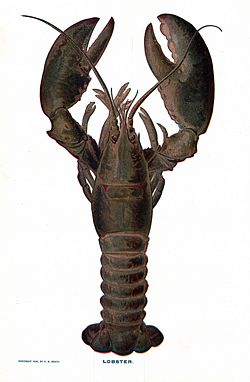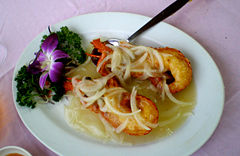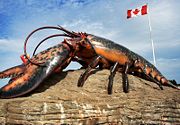Lobster
| Lobster | ||||||||||||||
|---|---|---|---|---|---|---|---|---|---|---|---|---|---|---|
 American lobster, Homarus americanus
|
||||||||||||||
| Scientific classification | ||||||||||||||
|
||||||||||||||
| Subfamilies and Genera | ||||||||||||||
|
Clawed lobsters compose a family (Nephropidae, sometimes also Homaridae) of large marine crustaceans. Lobsters are economically important as seafood, forming the basis of a global industry that nets US$1.8 billion in trade annually.
Though several different groups of crustaceans are known as "lobsters," the clawed lobsters are most often associated with the name. Clawed lobsters are not closely related with spiny lobsters or slipper lobsters, which have no claws (chelae), or squat lobsters. The closest relatives of clawed lobsters are the reef lobster Enoplometopus and the three families of freshwater crayfish.
Contents |
Biology
Lobsters are invertebrates and are found all over the world. They have a hard protective exoskeleton. Like most arthropods, lobsters must molt in order to grow, leaving them vulnerable during this time. During the molting process, several species may experience a change in color.
Lobsters live on rocky, sandy, or muddy bottoms from the shoreline to beyond the edge of the continental shelf. They generally live singly in crevices or in burrows under rocks.
Lobsters typically eat live food, consisting of fish, mollusks, other crustaceans, worms, and some plant life. Occasionally, they will scavenge if necessary, and may resort to cannibalism in captivity; however, this has not been observed in the wild. Lobster skin in the stomachs of lobsters has been found before, although this is because lobsters will eat their shed skin after molting.[1] Lobsters grow throughout their lives and it is not unusual for a lobster to live for more than 100 years.[2] In fact, lobsters may exhibit "negligible senescence", in that they can effectively live indefinitely, barring injury, disease, capture, etc. [3] They can thus reach impressive sizes. According to the Guinness World Records, the largest lobster was caught in Nova Scotia, Canada, and weighed 20.15 kg (44.4 lb).
Being arthropods, lobsters are largely bilaterally symmetrical; clawed lobsters often possess unequal, specialized claws, like the king crab. A freshly caught lobster will have a claw that is full and fleshy, not atrophied. The anatomy of the lobster includes the cephalothorax which is the head fused with the thorax, both of which are covered by the carapace, of chitinous composition, and the abdomen. The lobster's head consists of antennae, antennules, mandibles, the first and second maxillae, and the first, second, and third maxillipeds. Because a lobster lives in a murky environment at the bottom of the ocean, its vision is poor and it mostly uses its antennae as sensors. Studies have shown that the lobster eye is formed with a reflective structure atop a convex retina. In contrast, most complex eyes use refractive ray concentrators (lenses) and a concave retina.[4] The abdomen of the lobster includes swimmerets and its tail is composed of uropods and the telson.
A notable feature of a Lobster's blue blood is that it is made up of haemocyanin, found also in snails and spiders, which contains copper[5]. This is unlike haemoglobin which contains iron. Inside lobsters is a green goopy substance called tomalley, which serves as the hepatopancreas, fulfilling the functions of both liver and pancreas.[6]
In general, lobsters move slowly by walking on the bottom of the sea floor. However, when they are in danger and need to flee, they swim backwards quickly by curling and uncurling their abdomen. A speed of 5 meters per second (about 11 mph) has been recorded.[7] This is known as the Caridoid escape reaction
Lobsters come in a variety of colors including, but not limited to, red, blue, green, purple, and yellow.[8]
Symbion
The genus Symbion, the only member of the animal phylum Cycliophora, has only been found on the gills and mouthparts of lobsters.[9]
Gastronomy
| Lobster Nutritional value per 100 g (3.5 oz) |
||||||||||||||||||||||||||||||||||||||||||
|---|---|---|---|---|---|---|---|---|---|---|---|---|---|---|---|---|---|---|---|---|---|---|---|---|---|---|---|---|---|---|---|---|---|---|---|---|---|---|---|---|---|---|
| Energy 100 kcal 410 kJ | ||||||||||||||||||||||||||||||||||||||||||
|
||||||||||||||||||||||||||||||||||||||||||
| Percentages are relative to US recommendations for adults. Source: USDA Nutrient database |
||||||||||||||||||||||||||||||||||||||||||



Lobster is a valued foodstuff; well-known recipes include Lobster Newberg and Lobster Thermidor. Lobster is best eaten fresh, and they are normally purchased live. Lobsters are usually shipped and sold with their claws banded to prevent them from injuring each other or the purchaser. Lobsters cannot open and close the claws when they are banded, which causes the claws to begin to atrophy inside the shell. Recently banded lobsters will not show this, and the claws will be full. Many restaurants that serve lobster keep a tank of the live creatures, often allowing patrons to pick their own.
Lobsters are generally prepared and cooked while they are still alive, even though both claws may have been removed. Most cooks place the live lobster into a pot of boiling water or steam which kills it. Lobsters are also served fried, grilled, or baked. Freezing the lobster may toughen the meat.
When boiling, the lobster is simmered for 7 minutes for the first pound and 3 minutes for each additional pound.[10]
The majority of the meat is in the tail and the two front claws, but smaller quantities can be found in the legs and torso. Lobster can be boiled or steamed, or used in a wide array of dishes and salads. It can be served as soup or bisque or mixed with mayonnaise or salad dressing for lobster rolls. Lobster meat is often dipped in clarified butter, resulting in a sweetened flavor.
History
The European wild lobster, including the royal blue lobster of Audresselles, is more expensive and rare than the American lobster. It was consumed chiefly by the royal and aristocratic families of France and the Netherlands. Such scenes were depicted in Dutch paintings of the sixteenth and seventeenth centuries.
In North America prior to the 20th century, local lobster was not a popular food. In the Canadian Maritimes, eating lobster was considered a mark of poverty or as a food for slaves or lower members of society. Lobsters were also used as a fertilizer for farms. Outside of the rural outports lobster was sold canned.
The market for lobster changed with the development of the modern transportation industry that allowed live lobsters to be shipped from the ports to large urban centres. Fresh lobster quickly became a luxury food and a tourist attraction for the Maritime provinces and Maine and an export to Europe and Japan where it is especially expensive.
The high price of lobster has led to the marketing of "faux lobster" which is clearly labeled as such. It is often made from pollock or other whitefish that has been altered to look and taste similar to lobster. A few restaurants sell "langostino lobster". Langostino translates into prawn; however, the actual animal is probably a crab. Maine fishermen are upset that restaurants are passing off the fake as lobster. The spiny lobster is also called langouste. Rubio's Fresh Mexican Grill sold a "Lobster Burrito" which was made from squat lobster, another crustacean which is very similar to the crab.[11]
Catching
| commercial |
|---|
 |
| crustaceans |
| crab |
| crayfish |
| krill |
| lobster |
| shrimp |
|
|
| fishing industry |
| fisheries |
|
|
| I N D E X |
The usual method of catching lobsters has been to use baited, one-way traps located underwater with a color-coded marker buoy at the surface so that fishermen can find their cages. Lobster is fished in water between 1 and 500 fathoms, although the animal itself may range to 2,000 fathoms in some species. Cages may be made of plastic-coated galvanized steel or wood. A single lobsterman may tend between 10 and 2,000 traps depending on the fishery. Around the year 2000, due to overfishing of some species and demand overwhelming supply, many countries began to try lobster farming, which is similar to fish farming. As of 2008, no lobster farming operation has achieved commercial success yet.
Capacity for pain
- See also: Angling - Capacity for Pain
The question of whether or not lobsters can experience pain is unresolved. Because of the ambiguous nature of suffering, most people who contend that lobsters do have this capacity approach the issue using 'argument by analogy' — that is, they hold that certain similarities between lobsters' and humans' biology or behavior warrant an assumption that lobsters can feel pain.[12]
In February 2005, a review of the literature by the Norwegian Scientific Committee for Food Safety tentatively concluded that "it is unlikely that [lobsters] can feel pain," though they note that "there is apparently a paucity of exact knowledge on sentience in crustaceans, and more research is needed." This conclusion is based on the lobster's simple nervous system. The report assumes that the violent reaction of lobsters to boiling water is a reflex to noxious stimuli.[13]
However, review by the Scottish animal rights group Advocate for Animals released in the same year reported that "scientific evidence ... strongly suggests that there is a potential for [lobsters] to experience pain and suffering," primarily because lobsters (and other decapod crustaceans) "have opioid receptors and respond to opioids (analgesics such as morphine) in a similar way to vertebrates," indicating that lobsters' reaction to injury changes when painkillers are applied. The similarities in lobsters' and vertebrates' stress systems and behavioral responses to noxious stimuli were given as additional evidence for their capacity for pain.[12]
A 2007 study at Queen's University, Belfast, suggested that crustaceans do feel pain. Acetic acid was placed on the antennae of 144 prawns; the animals responded by rubbing the affected areas. Professor Robert Elwood, who headed the study, argues that sensing pain is crucial to the survival of all animals, because it encourages them to avoid damaging behaviors. Some scientists responded, saying the rubbing may reflect an attempt to clean the affected area.[14]
Opioids
In vertebrates, endogenous opioids are neurochemicals that moderate pain by interacting with opiate receptors. Opioid peptides and opiate receptors occur naturally in crustaceans, and although “at present no certain conclusion can be drawn,”[13] some have interpreted their presence as an indication that lobsters may be able to experience pain[13][12]. The aforementioned Scottish paper holds that lobsters' opioids may "mediate pain in the same way" as in vertebrates[12].
Morphine, an analgesic, and naloxone, an opioid receptor antagonist, may affect a related species of crustacean (Chasmagnathus granulatus) in much the same way they affect vertebrates: injections of morphine into crabs produced a dose-dependent reduction of their defensive response to an electric shock.[15] (However, the attenuated defensive response could originate from either the analgesic or sedative properties of morphine, or both[16]) These findings have been replicated for other invertebrate species,[16] but similar data is not yet available for lobsters.
Animal welfare issues
The most common way of killing a lobster is by placing it, live, in boiling water, or by splitting: severing the body in half, lengthwise.
The boiling method (also used to kill crayfish and shrimp) is controversial because some believe that the lobster suffers. The practice is illegal in some places, such as in Reggio Emilia, Italy, where offenders face fines of up to €495.[17] The Norwegian study states that the lobster may be de-sensitized by placing it in a salt solution 15 minutes before killing it.
Some stores will kill a lobster upon purchase by microwaving it. Whether or not death occurs more quickly than when the lobster is dropped in boiling water is not clear. There are, however, locations where the sale of a dead lobster to be eaten is illegal, including Massachusetts.[18]
In 2006, British inventor Simon Buckhaven invented the CrustaStun, which electrocutes lobsters with a 110 V electric shock, killing them in about five seconds. This ensures a quicker death for the lobster. Seafood wholesalers in Britain already use a commercial version. A home version measuring about 46 cm width and depth came into the retail market in late 2006 for about £2000.[19][20]
Lobsters in culture


The Moche people of ancient Peru worshipped the sea and its animals. Lobsters were often depicted in their art.[21] In the Japanese 1966 film Godzilla vs. the Sea Monster and the 1970 film Space Amoeba, the Toho monsters Ebirah and Ganime, respectively, are both giant mutant lobsters. A recurring character on the television show SpongeBob SquarePants is a bodybuilding lobster named Larry. A lobster is also the main character in Edward Harriman's children's book Leroy the Lobster and Crabby Crab.
In 1978, The B-52's released their first single, "Rock Lobster", which would go on to gain cult status in popular culture.
On May 31st, 2008 Nike SB Released a 'Lobster Dunk' Sneaker at Concepts in Cambridge, Massachussets[22].
In the series Futurama the character Dr. Zoidberg is based on a lobster
Although Acadians turned to lobster fishing only recently, lobster became an Acadian symbol in the 1990s and 2000's, very popular among tourists. Apart from the giant lobster in Shediac, souvenir shops around the maritimes sell plush lobsters. They appear on t-shirts, pins, and keychains; and semi-circular wooden lobster traps are a popular lawn ornament, even miles away from the coast. They often have the Acadian flag painted on them. That lobster mania grew stronger in 2003 as lobster-fisherman-turned-singer Wilfred Lebouthillier reached stardom in Quebec.
List of clawed lobster species
This list contains all known species in the family Nephropidae:[23]
|
|
References
- ↑ "Homarus americanus, Atlantic lobster". MarineBio.org. Retrieved on 2006-12-27.
- ↑ David Foster Wallace (2005). Consider the Lobster and Other Essays. Little, Brown & Company. ISBN 0-31-615611-6.
- ↑ Emerging Area of Aging Research: Long-Lived Animals with "Negligible Senescence", John C. Guerin. Annals of the New York Academy of Sciences 1019 (1) , 518–520. (abstract)
- ↑ Land, M. F. (1976). "Superposition images are formed by reflection in the eyes of some oceanic decapod Crustacea". Nature 263: 764–765. doi:.
- ↑ "Copper for life - Vital copper". ASE.
- ↑ Arsenic speciation in marine certified reference materials. doi:. http://www.rsc.org/delivery/_ArticleLinking/DisplayArticleForFree.cfm?doi=b314101b&JournalCode=JA.
- ↑ "The American lobster — frequently asked questions". St. Lawrence Observatory, Fisheries and Oceans Canada (2005-10-19).
- ↑ http://www.mytelus.com/ncp_news/article.en.do?pn=tech&articleID=3012956
- ↑ M. Obst, P. Funch & G. Giribet (2005). "Hidden diversity and host specificity in cycliophorans: a phylogeographic analysis along my ta tas the North Atlantic and Mediterranean Sea". Molecular Ecology 14: 4427–4440. doi:. http://www.blackwell-synergy.com/doi/abs/10.1111/j.1365-294X.2005.02752.x.
- ↑ "Cooking lobsters". Atwood Lobster Company. Retrieved on 2007-06-30.
- ↑ Sarah Skidmore (2005-07-01). "The lobster in Rubio's burrito may be in hot water", The San Diego Union-Tribune.
- ↑ 12.0 12.1 12.2 12.3 Cephalopods and decapod crustaceans: their capacity to experience pain and suffering. Advocates for Animals. 2005. http://www.advocatesforanimals.org.uk/pdf/crustreport.pdf.
- ↑ 13.0 13.1 13.2 L. Sømme (2005). "Sentience and pain in invertebrates: Report to Norwegian Scientific Committee for Food Safety". Norwegian University of Life Sciences, Oslo.
- ↑ Sample, Ian. "Blow for fans of boiled lobster: crustaceans feel pain, study says", The Guardian, Nov 8, 2007.
- ↑ M. Lozada, A. Romano & H. Maldonado (1988). "Effect of morphine and naloxone on a defensive response of the crab Chasmagnathus granulatus". Pharmacology Biochemistry and Behavior 30 (3): 635–640. doi:.
- ↑ 16.0 16.1 V. E. Dyakonova (2001). "Role of opioid peptides in behavior of invertebrates". Journal of Evolutionary Biochemistry and Physiology 37: 335–347. doi:. http://www.ingentaconnect.com/content/maik/joey/2001/00000037/00000004/00366536.
- ↑ Bruce Johnston (2004-03-06). "Italian animal rights law puts lobster off the menu", Daily Telegraph.
- ↑ "Chapter 94: Section 77G. Use of dead lobsters for food purposes; rapid freezing of live lobsters". Massachusetts General Court.
- ↑ "Lawyer invents lobster stun-gun", BBC News (2006-06-18).
- ↑ Brendan I. Koerner (2006-06-25). "How a Lobster Leaves the Building", New York Times.
- ↑ Berrin, Katherine & Larco Museum. The Spirit of Ancient Peru:Treasures from the Museo Arqueológico Rafael Larco Herrera. New York: Thames and Hudson, 1997
- ↑ NikeSB.org (May 25, 2008). "NIKE SB CONCEPTS LOBSTER DUNK - CAMBRIDGE, MASS. MAY 31ST 2008". Press release. Retrieved on 2008-11-05.
- ↑ Tshudy, D (2003). "Clawed lobster (Nephropidae) diversity through time". Journal of Crustacean Biology 23: 178–186. doi:. http://www.bioone.org/perlserv/?request=get-abstract&issn=0278-0372&volume=023&issue=01&page=0178.